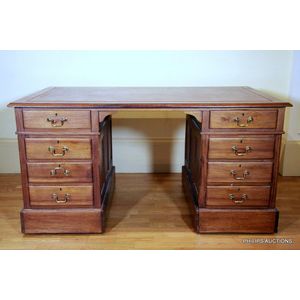1920s Mahogany Roll Top Desk with Green Leather Surface
You must be a subscriber, and be logged in to view price and dealer details.
Subscribe Now to view actual auction price for this item
When you subscribe, you have the option of setting the currency in which to display prices to $Au, $US, $NZ or Stg.
- Pedestal - The columns that support many dining tables and most small occasional tables. They are usually turned, though octagonal-shaped pedestals were fashionable during the 1830s and 1840s.
- Circa - A Latin term meaning 'about', often used in the antique trade to give an approximate date for the piece, usually considered to be five years on either side of the circa year. Thus, circa 1900 means the piece was made about 1900, probably between 1895 and 1905. The expression is sometimes abbreviated to c.1900.
- Kneehole - A recessed section, mainly found on Georgian desks and dressing tables, which does not go through the full depth of the item, and usually terminates in a cupboard at the back.
- Blind Tooling / Blind Tooled - Blind tooling is a technique used in the decoration of leather goods such as book covers, belts, and wallets. It involves the use of specialized tools to impress designs and patterns onto the surface of the leather without the use of added colour.
The process involves the use of a variety of tools, including stamps, embossing tools, and finishing tools, which are used to create various textures and patterns on the leather surface. The tools are heated, and then pressed onto the leather, leaving an impression. The tools can be used to create designs that are simple or complex, with a variety of textures and patterns, including geometric shapes, florals, or scenes. The leather is then burnished to enhance the design and give it a smooth finish. - Mahogany - Mahogany is a dense, close grained red-coloured timber from the West Indies and Central America. It was first imported into Europe in the the early 18th century and its use continued through the 19th century. It was popular for furniture making because of its strength, the wide boards available, the distinctive grain on some boards, termed flame mahogany and the rich warm colour of the timber when it was polished.. The "flame" was produced where a limb grew out from the trunk of the tree, and this timber was usually sliced into veneers for feature panels on doors, backs and cornices.
Some terms used to describe mahogany relate to the country from which it originally came, such as "Cuban" mahogany, "Honduras" mahogany etc. However unless the wood has been tested the names assigned are more a selling feature, rather than a true indication of the timber's origin. - Tambour - A form of folding shutter formed by narrow widths of wood with the flat side glued to canvas, and used on some writing desks, sideboards and other cabinets.
The tambours may run vertically and enclose some stationery compartments, such as in a lady's writing desk. Or the tambours may run horizontally, such as in a Cutler desk, and form an enclosure for the whole of the writing surface. - Roll Top - A term introduced in the 19th century to describe a desk with a sliding enclosed top.
- Tooled - Decoration of a leather surface, usually by stamping the surface with a heated punch or wheel containing foliate or geometric designs. In blind tooling the surface of the punch or wheel is in direct contact with the leather, while in gold tooling, a ribbon of gold leaf is placed between the punch or wheel and the leather, and once they have been applied, the excess gold is brushed off, leaving only the design.
- Stile - A cabinetmaker's term that refers to the vertical end members of the framework in a panelled item of furniture. The vertical mid-members are known as muntins.
This item has been included into following indexes:
-
desks, style or type
- roll top 104
- tambour top 35
Visually similar items

A fine walnut partners desk, mid 1940s. The double pedestal desk with four cockbeaded drawers and cast swing handles, cupboards to the reverse long side and raised on an Art Deco waisted plinth base, with a bevel glazed top. Provenance: The property of the

Andrew Lenehan cedar partners desk each pedestal with five drawers and cupboard, leather top, stamp to right hand top drawer 'A. Lenehan'. Height 74 cm width 137 cm depth 89 cm

A late Victorian twin pedestal desk in quarter cut oak.

A hardwood partner's desk, mid 20th century, the desk with a brown leather gilt tooled surface, the pedestals each with four drawers with brass swing handles and raised on plinth bases, cupboards to the reverse. Height 78 cm, width 152 cm, depth 90 cm
